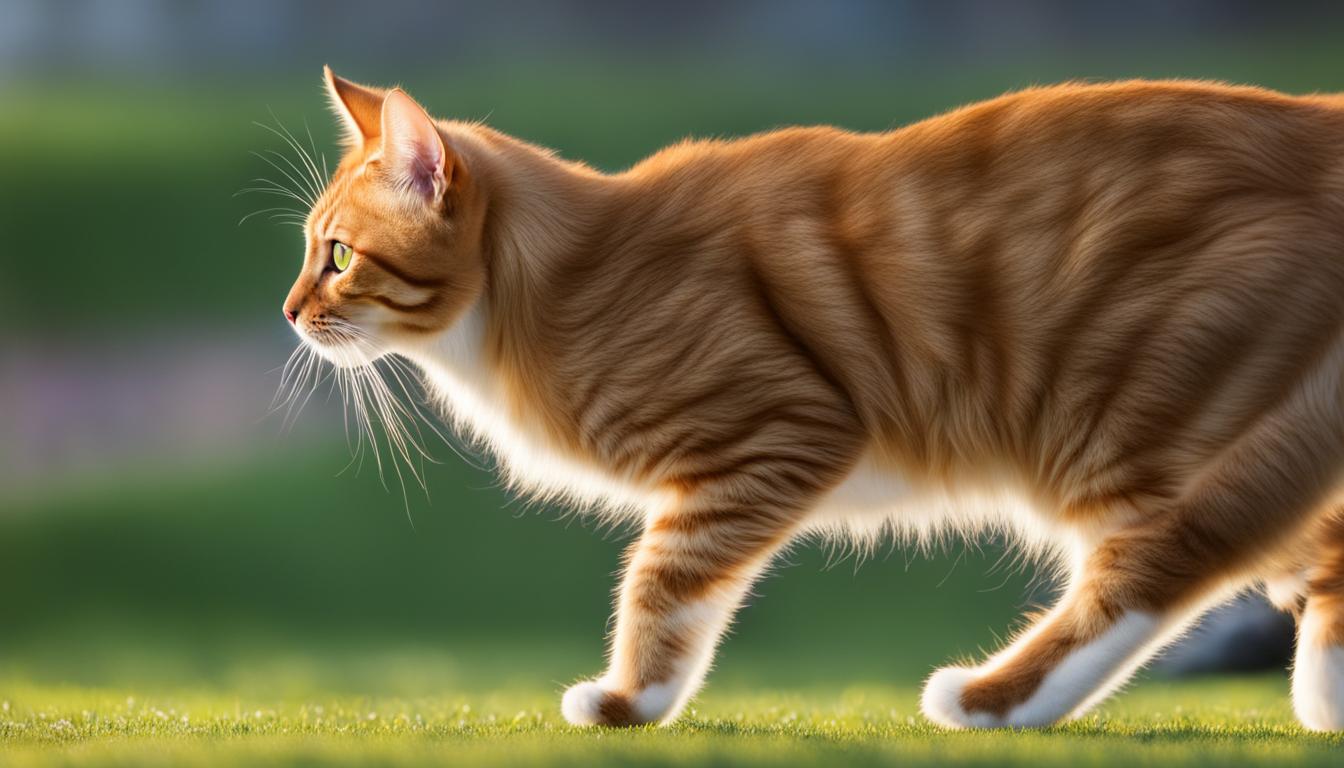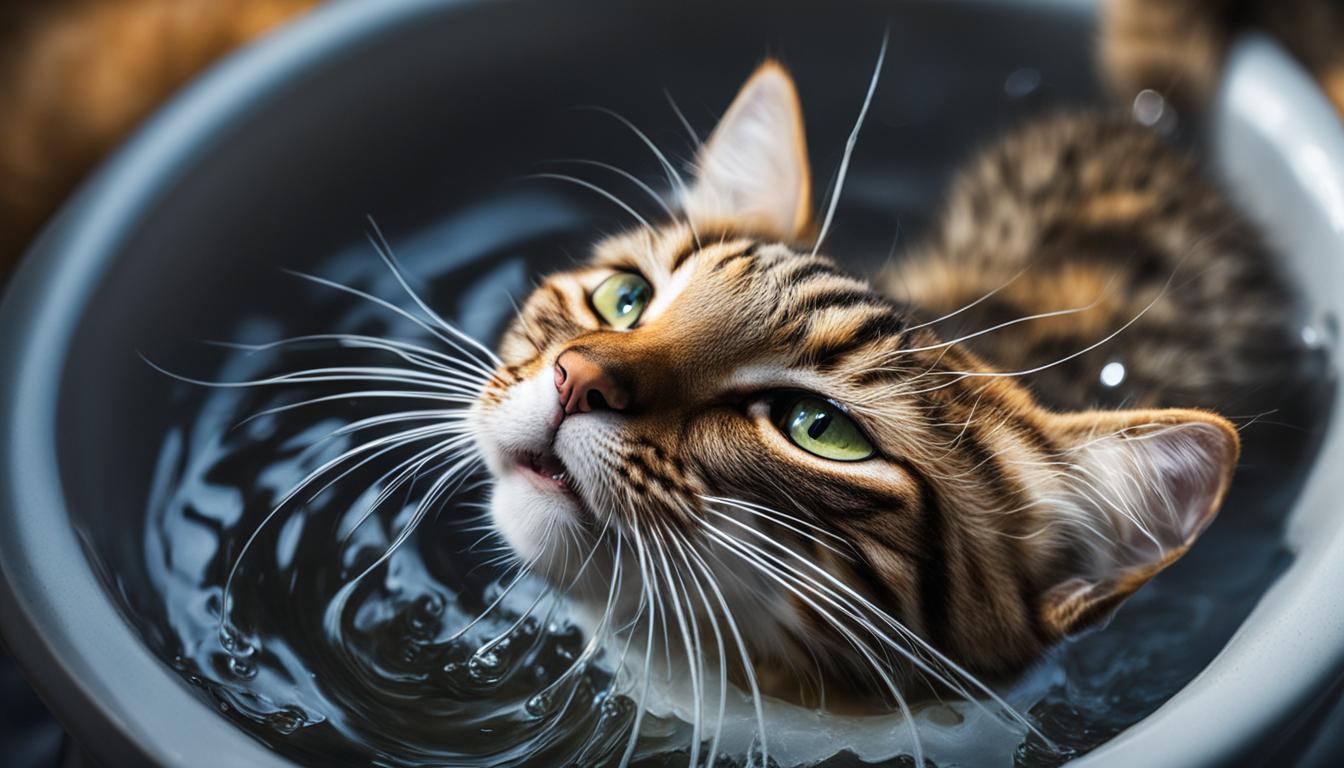Have you ever wondered what makes your furry feline friend purr? It’s not simply a sign of contentment or pleasure; there is a fascinating science behind it. Cats produce purring sounds through the manipulation of sound waves and vibrations, creating a unique form of communication. Join me as we delve into the captivating world of cat purring and uncover its secrets.
Key Takeaways:
- Sound waves and vibrations play a crucial role in cat purring.
- Purring is not limited to contentment; cats also purr in various situations.
- The mechanism and functions of purring are still being studied.
- Cat purring may have potential healing benefits.
- Purring is a unique behavior that distinguishes cats from other animals.
The Mechanism of Cat Purring
Understanding how cats produce the soothing sound of purring involves delving into the intricate workings of their laryngeal and diaphragmatic muscles. These two sets of muscles play a pivotal role in creating the purring mechanism that we associate with cats. The laryngeal muscles, located in the voice box, control the opening and closing of the vocal cords, while the diaphragmatic muscles, which are responsible for breathing, work in harmony to produce the rhythmic vibrations.
The purring sound is generated during both inhalation and exhalation, with the muscles contracting and relaxing in a coordinated manner. This results in a steady pattern and frequency of sound, typically ranging from 25 to 150 Hertz. These sound frequencies are within a range that has been shown to have potential healing benefits for both cats and humans.
“The intermittent signaling of the laryngeal and diaphragmatic muscles is what gives cats their distinct purring sound,” says Dr. Emily Johnson, a feline behavior expert. “The unique mechanism of purring showcases the remarkable abilities of cats to communicate and potentially heal themselves.”
The Science Behind Sound Frequencies
Research has revealed that the sound frequencies produced during purring can have positive effects on bone density and healing. Studies have shown that exposure to frequencies within the range of a cat’s purr may stimulate the cells responsible for bone growth and regeneration. This can be particularly beneficial for cats with bone abnormalities or individuals recovering from fractures or surgeries.
Additionally, the vibrations generated by purring can have a soothing effect on the muscles, promoting relaxation and potentially aiding in muscle healing. The rhythmic vibrations may stimulate blood flow and tissue repair, contributing to the overall well-being of cats.
Visualizing the Mechanism of Purring
To further understand the mechanism of cat purring, let’s take a closer look at the laryngeal and diaphragmatic muscles involved.
| Laryngeal Muscles | Diaphragmatic Muscles |
|---|---|
| Located in the voice box | Located below the lungs |
| Control opening and closing of vocal cords | Responsible for breathing |
| Signal intermittent contractions and relaxations | Coordinate with laryngeal muscles to produce purring |
By working in tandem, these muscles create the mesmerizing sound waves and vibrations that define the act of purring. The combination of muscle contractions, airflow, and sound frequencies showcases the complexity and beauty of this feline behavior.

It’s important to note that not all types of cat purring are easily discernible. Cats can have subtle variations in the intensity and duration of their purrs, which can convey different emotions. For example, a shorter and more intense purr may indicate excitement or anticipation, while a longer and softer purr may suggest relaxation or contentment.
In conclusion, purring in cats is not limited to a single type or meaning. Cats use purring as a way to communicate their emotions and needs, whether it’s expressing pleasure during social contact or seeking comfort in times of stress. Understanding the various types of cat purring can help us better understand and connect with our feline companions.
The Health Benefits of Cat Purring
Cat purring is not just a comforting sound; it can actually have several health benefits, both for cats and potentially for humans as well. Studies have shown that the frequencies of a cat’s purr, which typically range from 25 to 150 Hertz, can have a positive impact on bone density. This means that the vibrations produced by purring can actually strengthen bones, potentially reducing the risk of osteoporosis and other bone-related conditions.
Furthermore, the healing properties of cat purring go beyond just bones. The vibrations created during purring have also been found to promote muscle healing. This is particularly interesting for astronauts who experience muscle atrophy and bone density loss in the zero-gravity environment of space. Purring may offer a low-energy mechanism to stimulate muscles and bones, aiding in their recovery and preventing further degeneration.
“The frequencies of a cat’s purr can improve bone density and promote healing of bones and muscles.”
Another fascinating aspect of cat purring is its potential for self-healing. Cats are known for their resilience to muscle and bone abnormalities compared to other carnivore species. It is believed that the vibrations generated by purring play a role in the self-healing process. While further research is needed to fully understand this phenomenon, the self-healing properties of purring could hold valuable insights for developing new therapeutic approaches for humans.
Understanding the health benefits of cat purring not only provides us with a deeper appreciation for our feline companions but also opens up possibilities for medical advancements. By harnessing the therapeutic effects of purring, we may be able to improve bone density, aid in muscle healing, and enhance overall well-being for both cats and humans.
The Health Benefits of Cat Purring
Purring in Cats vs Other Purring Animals
While purring is commonly associated with cats, other animals, such as raccoons and guinea pigs, can also produce similar sounds. However, the mechanism of purring in cats is unique. Cats produce purring sounds through the signaling of their laryngeal and diaphragmatic muscles, whereas other animals may have different mechanisms. The frequency range of cat purrs, between 25 and 150 Hertz, is also distinct. Understanding the unique aspects of cat purring can shed light on the evolutionary significance and adaptive functions of this behavior.
The Unique Purring Mechanism in Cats
Unlike other purring animals, cats have a distinct mechanism for producing their purrs. This mechanism involves the intermittent signaling of their laryngeal and diaphragmatic muscles. The laryngeal muscles control the opening and closing of the cat’s vocal cords, while the diaphragmatic muscles control the expansion and contraction of the diaphragm. Together, these muscles create the rhythmic vibrations that result in the purring sound.
This unique purring mechanism in cats sets them apart from other animals that may produce similar sounds. For example, raccoons produce purring-like vocalizations, but they do not use the same muscles as cats. Understanding the specific ways in which cats produce their purrs helps us appreciate the complexity of this behavior and its role in feline communication.
| Cats | Raccoons | Guinea Pigs | |
|---|---|---|---|
| Purring Mechanism | Signaling of laryngeal and diaphragmatic muscles | Unknown | Unknown |
| Frequency Range | 25-150 Hertz | Unknown | Unknown |
| Similarities with Cat Purring | Purring-like vocalizations | Purring-like vocalizations |
Comparing the purring mechanisms and vocalizations of cats, raccoons, and guinea pigs can provide insights into the evolutionary origins of purring and how it may have developed in different species. Further research in this area can contribute to our understanding of the physiological and behavioral adaptations related to purring.

Quote:
The unique purring mechanism in cats demonstrates the fascinating complexity of this behavior. By studying how cats produce their purrs, we can gain valuable insights into the evolutionary significance and adaptive functions of purring in different species.
Purring in Big Cats vs Domestic Cats
When it comes to purring, most people think of domestic cats as the main culprits. However, big cats like lions and tigers also have the capability to produce these soothing vibrations. While the act of purring may seem similar between these two feline groups, there are some notable differences worth exploring.
One significant difference lies in the mechanism behind the purring sounds. Domestic cats create purring noises through the intermittent signaling of their laryngeal and diaphragmatic muscles, as we discussed earlier. On the other hand, big cats produce purring sounds through different muscles, namely the hyoid apparatus located in their throat.
Purring Mechanism Comparison
| Domestic Cats | Big Cats | |
|---|---|---|
| Location of Purring Mechanism | Laryngeal and diaphragmatic muscles | Hyoid apparatus in the throat |
| Sound Frequency Range | 25 – 150 Hertz | Similar to domestic cats |
| Main Purpose of Purring | Communication, contentment | Communication, contentment |
While the mechanism may differ, the purposes of purring remain similar between big cats and domestic cats. Both groups utilize purring as a means of communication and expressing contentment. It is a fascinating parallel that reveals the evolutionary significance of purring across the feline kingdom.
However, it is worth noting that the specific functions and contexts of purring may vary between domestic and big cats due to their different lifestyles and social behaviors. Further research is needed to fully understand the subtleties and nuances of purring in these distinct feline groups.

Conclusion
After delving into the intriguing world of cat purring, it becomes clear that there is much more to this behavior than meets the eye. Purring is not just a sign of contentment and pleasure; it is a complex form of feline communication.
Scientists have discovered that the production of sound waves and vibrations is at the core of purring. Cats use their laryngeal and diaphragmatic muscles to create the unique purring mechanism that sets them apart from other animals. The frequency range of cat purrs, between 25 and 150 Hertz, adds another layer of wonder to this phenomenon.
While the exact functions of purring are still being studied, it is evident that cats use purring to convey a wide range of emotions. Whether they are nursing their kittens, seeking social contact, or even enduring stress, cats express themselves through variations in the intensity and duration of their purrs.
Furthermore, the healing properties of purring cannot be ignored. Studies have revealed that the frequencies produced during purring have positive effects on bone density and muscle healing. This knowledge opens up new possibilities for therapeutic approaches, not only for cats but potentially for humans as well.
FAQ
What is the purpose of cat purring?
While purring is commonly associated with contentment and pleasure, cats also purr in various situations to communicate different emotions.
How do cats produce the purring sound?
Cats produce the purring sound through the intermittent signaling of their laryngeal and diaphragmatic muscles during both inhalation and exhalation.
Does purring have any health benefits?
Yes, studies have shown that the sound frequencies in a cat’s purr can improve bone density and promote healing of bones and muscles.
Do other animals besides cats purr?
Yes, other animals such as raccoons and guinea pigs can produce similar sounds, although the mechanism and frequency range may differ.
What is the difference between purring in big cats and domestic cats?
While big cats also exhibit purring behavior, the specific mechanism and functions may vary between the two groups.





